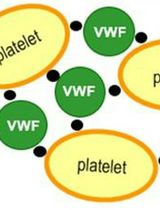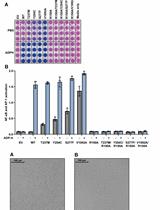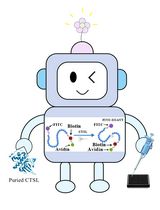- EN - English
- CN - 中文
Quantitative Measurement of the Kinase Activity of Wildtype ALPK1 and Disease-Causing ALPK1 Mutants Using Cell-Free Radiometric Phosphorylation Assays
野生型和致病突变体ALPK1激酶活性的无细胞放射性磷酸化定量测定
发布: 2024年11月20日第14卷第22期 DOI: 10.21769/BioProtoc.5124 浏览次数: 1451
评审: Ralph Thomas BoettcherMasashi AsaiMartin V Kolev
Abstract
ALPK1 is an atypical protein kinase that is activated during bacterial infection by ADP-heptose and phosphorylates TIFA to activate a cell signaling pathway. In contrast, specific mutations in ALPK1 allow it to also be activated by endogenous human nucleotide sugars such as UDP-mannose, leading to the phosphorylation of TIFA in the absence of infection. This protocol describes a quantitative, cell-free phosphorylation assay that can directly measure the catalytic activity of wildtype and disease-causing ALPK1 in the presence of different nucleotide sugars. In this method, overexpressed ALPK1 is first immunoprecipitated from the extracts of ALPK1 knockout HEK-Blue cells transfected with plasmids encoding either FLAG-tagged wildtype or mutant ALPK1, and then subjected to a radioactive phosphorylation assay in which the phosphorylation of purified GST-tagged TIFA by ALPK1 is quantified by measuring the incorporation of radioactivity derived from radiolabeled ATP.
Key features
• Quantitative measurement of protein kinase activity of wildtype and mutant ALPK1 in the presence or absence of different nucleotide sugars such as ADP-heptose and UDP-mannose.
• Cell-free experimental setup overcoming the challenge of distinguishing constitutive activity and activation by endogenous mammalian metabolites in cell-based assays.
• Requires approximately 50 µg of cell extract protein/reaction, allowing up to 150 assays to be performed from an extract prepared from a single 15 cm dish of transfected cells.
Keywords: ALPK1 (ALPK1)Background
Alpha-protein kinase 1 (ALPK1) is an atypical protein kinase that is activated by the binding of the bacterial metabolite ADP-heptose to its N-terminal domain [1]. This allows ALPK1 to phosphorylate TIFA (TRAF-interacting protein with forkhead-associated domain), which in turn triggers its polymerization into TIFAsomes that initiate signaling events that lead to the activation of transcription factors such as NF-κB and AP-1 [1,2] (see [3] for a schematic overview of the ADP-heptose signaling pathway).
Mutations in ALPK1 are the cause of at least two human diseases. The Thr237Met, Tyr254Cys, and Ser277Phe mutations cause ROSAH syndrome (retinal dystrophy, optic nerve edema, splenomegaly, anhidrosis, and migraine headache), which is an autosomal dominant genetic disorder [4–6], whereas the ALPK1[V1092A] mutation is a driver of spiradenoma, a rare type of hair follicle tumor that can transform into a malignant form called spiradenocarcinoma, which is invariably fatal [7]. These mutations allow ALPK1 to be activated by endogenous mammalian nucleotide sugars, such as UDP-mannose and ADP-ribose, in addition to bacterial ADP-heptose, leading to pathological signaling in the absence of bacterial infection [3,6].
This protocol describes a cell-free phosphorylation assay that can be used to quantify the protein kinase activity of wildtype and mutant forms of ALPK1 in the presence or absence of different nucleotide sugars. Existing methods for measuring the activity of ALPK1 mutants have relied on measuring their activity within cells, but the complexity of the intracellular environment makes it challenging to identify specific activators. Furthermore, these cell-based methods rely on indirect measurements of ALPK1 activity after many hours, such as the activation of transcription factors or the secretion of cytokines or chemokines. In contrast, this phosphorylation assay has the advantage of enabling rapid and quantitative measurements of ALPK1 activity by directly measuring its ability to phosphorylate TIFA in a cell-free system. Additionally, this assay is ideal for validating potential ALPK1 inhibitors by studying their potency and selectivity for targeting wildtype or mutant forms of this protein kinase.
Materials and reagents
Biological materials
Cells should be cultured by incubation at 37 °C with 5% CO2 and tested regularly for mycoplasma using a MycoAlert Mycoplasma Detection Kit (Lonza, catalog number: LT07-318). The cells should be passaged once confluent at a ratio of 1:10 (v/v), and not used beyond 30 passages.
ALPK1 knockout (KO) HEK-Blue cells (InvivoGen, #hkb-koalpk)
General reagents
Storage conditions are given in parentheses unless it is room temperature.
ADP-L-heptose triethylammonium salt (InvivoGen, catalog number: tlrl-adph-l) (-80 °C)
Note: Resuspend 250 µg in 3,470 µL of reaction buffer (see Recipes) to generate a 0.1 mM stock.
UDP-α-D-mannose triethylammonium salt (synthesized in-house, available upon request) (-80 °C)
Note: Resuspend 2 mg in 3,280 µL of reaction buffer to generate a 1 mM stock.
ADP-D-ribose sodium salt (Sigma-Aldrich, catalog number: C7344) (-80 °C)
Note: Resuspend 2 mg in 3,580 µL of reaction buffer to generate a 1 mM stock.
3,000 Ci/mmol [γ32P]ATP (Revvity, catalog number: BLU002A001MC) (-20 °C)
Caution: [γ32P]ATP must be handled according to radioactivity safety regulations. Exposure to radiation must be minimized by working behind a plexiglass shield and storing samples in plexiglass boxes.
Dulbecco’s modified Eagle’s medium (DMEM) (Gibco, catalog number: 11960-085) (4 °C)
200 mM L-Glutamine (Gibco, catalog number: 25030024) (-20 °C)
Penicillin-Streptomycin 100× stock (Gibco, catalog number: 15140122) (-20 °C)
OptiMEM I reduced serum medium (Gibco, catalog number: 31985062) (4 °C)
Lipofectamine 2000 (Thermo Fisher, catalog number: 11668019) (4 °C)
Trypan Blue solution (Gibco, catalog number: 11538886)
Anti-FLAG M2 affinity resin (Millipore, catalog number: A2220)
Phosphate-buffered saline (PBS) (Gibco, catalog number: 10010023) (4 °C)
10 mM ATP (Thermo Fisher, catalog number: PV3227) (-20 °C)
Note: This commercial stock solution does not contain magnesium ions.
5 M NaCl (Sigma-Aldrich, catalog number: S6546)
1 M DTT (Thermo Fisher, catalog number: P2325) (-20 °C)
Note: Prepare 0.1 mL single-use aliquots.
1 M Tris-HCl (pH 7.5) (Thermo Fisher, catalog number: 15567027)
0.5 M EGTA (pH 8.0) (Thermo Fisher, catalog number: J60767.AD)
0.5 M EDTA (pH 8.0) (Sigma-Aldrich, catalog number: 03690)
10% (v/v) Triton X-100 (Sigma-Aldrich, catalog number: 93443) (4 °C)
Fetal bovine serum (FBS) (Sigma-Aldrich, catalog number: F7524) (-20 °C)
Sucrose powder (VWR, catalog number: 27480.360)
InstantBlue protein stain (Abcam, catalog number: ab119211) (4 °C)
MOPS SDS running buffer 20× stock (Formedium, catalog number: SDS5000)
NuPAGE LDS sample buffer 4× stock (Thermo Fisher, catalog number: NP0007)
Precision Plus protein standards (Bio-Rad, catalog number: 1610374) (-20 °C)
2-Mercaptoethanol (Sigma-Aldrich, catalog number: M6250)
Bovine serum albumin (BSA) (Sigma-Aldrich, catalog number: 810533) (4 °C)
Bradford Protein Assay Kit (Thermo Fisher, catalog number: 23200) (4 °C)
1 M Magnesium acetate (MgAc) (Sigma-Aldrich, catalog number: 63052)
Trypsin-EDTA solution (Gibco, catalog number: 25200056) (4 °C)
Complete EDTA-free protease inhibitor cocktail (Roche, catalog number: 11873580001) (4 °C)
Purified proteins
TIFA was purified from bacteria as a GST fusion and is available upon request via the MRC PPU Reagents and Services website (https://mrcppureagents.dundee.ac.uk).
GST-TIFA[2-184] (MRC PPU Reagents and Services, catalog number: DU4241) (-80 °C)
Note: Dialyzed against reaction buffer and stored at 1 mg/mL in single-use aliquots.
Plasmids
These plasmids encode FLAG-ALPK1 or FLAG alone (empty vector control) under a CMV promoter and were purified using NucleoBond Xtra Midi Endotoxin-Free kits (Macherey-Nagel, catalog number: 740420). The yield was ~0.5 mg, resuspended to 0.5 mg/mL in endotoxin-free water. They are stored at -20 °C.
pcDNA5-FRT/TO-FLAG-ALPK1 (MRC PPU Reagents and Services, catalog number: DU65668)
pcDNA5-FRT-TO-FLAG-ALPK1[S277F] (MRC PPU Reagents and Services, catalog number: DU71952)
pcDNA5-FRT-TO-FLAG (MRC PPU Reagents and Services, catalog number: DU41457)
Solutions
Culture media (see Recipes)
Lysis buffer (see Recipes)
Wash buffer (see Recipes)
Salt wash buffer (see Recipes)
Reaction buffer (see Recipes)
Radioactive ATP solution (see Recipes)
Recipes
Culture media (1 bottle)
Reagent Final concentration Amount to add DMEM Not applicable 500 mL FBS 10% (v/v) 50 mL 20 mM L-glutamine 2 mM 5.6 mL Penicillin-Streptomycin 100× 1× 5.6 mL Store at 4 °C.
Lysis buffer (50 mL)
Reagent Final concentration Amount to add 1M Tris-HCl (pH 7.5) 50 mM 2.5 mL Sucrose powder 270 mM 4.6 g 10% (v/v) Triton X-100 1% (v/v) 5 mL 0.5 M EDTA (pH 8.0) 1 mM 100 µL 0.5 M EGTA (pH 8.0) 1 mM 100 µL 1 M DTT 2 mM 100 µL Protease inhibitor cocktail 1× 1 tablet Water Not applicable 42.2 mL Use immediately.
Wash buffer (1 L)
Reagent Final concentration Amount to add 1 M Tris-HCl (pH 7.5) 50 mM 50 mL 10% (v/v) Triton X-100 0.1% (v/v) 10 mL 1 M DTT 2 mM 2 mL Water Not applicable 938 mL Store at 4 °C. Use within 1 month.
Salt wash buffer (1 L)
Reagent Final concentration Amount to add 1 M Tris-HCl (pH 7.5) 50 mM 50 mL 10% (v/v) Triton X-100 0.1% (v/v) 10 mL 5 M NaCl 0.5 M 100 mL 1 M DTT 2 mM 2 mL Water Not applicable 838 mL Store at 4 °C. Use within 1 month.
Reaction buffer (1 L)
Reagent Final concentration Amount to add 1 M Tris-HCl (pH 7.5) 50 mM 50 mL 0.5 M EGTA (pH 8.0) 1 mM 2 mL 1 M DTT 2 mM 2 mL 1 M MgAc 10 mM 10 mL Water Not applicable 937.6 mL Store at 4 °C. Use within 1 month.
Radioactive ATP solution (150 µL) (sufficient for 60 kinase reactions)
Reagent Final concentration Amount to add Undiluted [γ32P]ATP Not applicable 5–30 µL* 10 mM ATP 1 mM 15 µL Reaction buffer (recipe 5) Not applicable 105–130 µL Use immediately.
*The amount of undiluted [γ32P]ATP added to the radioactive ATP solution should be calculated based on the activity reference date to achieve a specific activity of approximately 500 cpm per pmol of ATP for each experiment.
Laboratory supplies
15 cm Nunc cell culture dishes (Thermo Fisher, catalog number: 168381)
15 and 50 mL conical centrifuge tubes (Greiner, catalog numbers: 188271 and 227261)
250 mL and 1 L Duran bottles (Thermo Fisher, catalog numbers: FB-800-250 and FB-800-1000)
Serological pipettes (Thermo Fisher, catalog number: 10710810)
Safe-lock 1.5 mL microcentrifuge tubes (Eppendorf, catalog number: 30123611)
Note: Safe-lock tubes are highly recommended to avoid losing the sample during end-to-end rotation.
Cellometer counting chamber (Nexcelom, catalog number: 11522186)
Spin-X 0.22 μm columns (Costar, catalog number: 8161)
NuPAGE Bis-Tris 4%–12% 20-well gels (Thermo Fisher, catalog number: WG1402BOX)
80-well cooling chamber for 1.5 mL tubes (Diversified Biotech, catalog number: CHAM-8000)
Swann-Morton number 22 disposable scalpels (Scientific Laboratory Supplies, catalog number: INS4767)
Equipment
The equipment mentioned below are standard laboratory items, and alternatives can be used in all cases.
Cellometer Auto 2000 (Nexcelom Bioscience)
Pipetman 4-Pipette Kit (Gilson, catalog number: F167360)
Stripettor Ultra Pipet Controller (Corning, catalog number: 4099)
Thermomixer (Eppendorf, model: Comfort 5355)
Cell culture incubator (Binder, model: CB150)
Cell culture hood (Conditioned Air Solutions, model: BioMAT 2-SF)
Liquid scintillation counter (Revvity, model: Tri-Carb 4910 TR)
Geiger counter
Plexiglas benchtop shield
Allegra X-12 benchtop centrifuge (Beckman Coulter, catalog number: 392474)
Benchtop microcentrifuge (Fisherbrand, model: Micro STAR 17)
Refrigerated benchtop microcentrifuge (Fisherbrand, model: Accuspin Micro 17)
Dry block heater (Grant, model: QBT2)
NuPAGE XCell SureLock Midi-Cell system (Invitrogen)
Plate reader (BioTek, model: Epoch)
Software and datasets
Image Lab (BioRad, Version 6.0.1)
Procedure
文章信息
稿件历史记录
提交日期: Jul 25, 2024
接收日期: Sep 27, 2024
在线发布日期: Oct 15, 2024
出版日期: Nov 20, 2024
版权信息
© 2024 The Author(s); This is an open access article under the CC BY license (https://creativecommons.org/licenses/by/4.0/).
如何引用
Snelling, T. (2024). Quantitative Measurement of the Kinase Activity of Wildtype ALPK1 and Disease-Causing ALPK1 Mutants Using Cell-Free Radiometric Phosphorylation Assays. Bio-protocol 14(22): e5124. DOI: 10.21769/BioProtoc.5124.
分类
生物化学 > 蛋白质 > 活性
细胞生物学 > 细胞信号传导 > 磷酸化
您对这篇实验方法有问题吗?
在此处发布您的问题,我们将邀请本文作者来回答。同时,我们会将您的问题发布到Bio-protocol Exchange,以便寻求社区成员的帮助。
提问指南
+ 问题描述
写下详细的问题描述,包括所有有助于他人回答您问题的信息(例如实验过程、条件和相关图像等)。
Share
Bluesky
X
Copy link












